
Hartland Abbey is a former abbey and current family home to the Stucley family. It is located in Hartland, Devon. The current owner is Sir Hugh George Copplestone Bampfylde Stucley, 6th Baronet.

Hartland Abbey is a former abbey and current family home to the Stucley family. It is located in Hartland, Devon. The current owner is Sir Hugh George Copplestone Bampfylde Stucley, 6th Baronet.
Hartland Abbey was built in 1157 and consecrated by Bartholomew Iscanus in 1160. [1] (Bartholomew was appointed Bishop of Exeter the following year.) Hartland was of the Augustinian order. The Botreaux family of Boscastle, Cornwall, were among the most generous donors to the Abbey. (Male heirs were apparently all named William, until the death in 1462 of the last of the line William de Botreaux, 3rd Baron Botreaux.) In 1187 a William de Botreaux gave the advowsons of the churches in his manors of Molland [2] and Knowstone in Devon, and of the church of Forrabury in his Cornish manor of Boscastle, to the Abbey. The grants were confirmed by a charter temp. from King Richard I (1189-1199) and the property was converted into an Augustinian Abbey in 1189.
In 1539 it was dissolved by Henry VIII. The King gave the building to William Abbot, his Sergeant of the Wine Cellar at Hampton Court. Along with the Priory at Bodmin, which Abbott soon sold to the use of that town. [1] William Abbot converted what had been the Abbot's Lodging into a mansion. In September 1544 the following lands of "Hartland Priory" were granted, with other lands, by Henry VIII to Thomas Godwyne in fee, for a consideration of £1,122 2s 6d: "the messuage, etc., called Abbottes in the parish of Molland alias Batters Moland (i.e. "Molland Bottreaux"), Devon, in tenure of Anthony Deye and a messuage, etc., in Moore alias Moore Town, in Bedyford (i.e. Bideford)parish, Devon, in tenure of Richard Penhorewod" [3] In March 1547 a royal licence was obtained by James Gunter and Henry Wescott, who presumably had been granted them on dissolution, to alienate the "rectory and advowson of the vicarage of Knoweston and Molland, Devon" to Hugh Culme. [4]
The present house incorporates a few components from Tudor times, including some fine wainscoting. The addition of two wings in 1705 are attributed to John Meadows, who also worked on Eggesford House and Arlington, on which commission he died. A fine interior exists and has examples from the 'Gothik' work of Batty Langley. The main ranges of the house were taken down to the level of the cloisters and rebuilt in the Strawberry Hill Gothic style, made popular by Lord Walpole. Further alterations were commissioned by Sir George Stucley in the mid-1800s. He engaged George Gilbert Scott and the building was remodelled to give a formal entrance through a new porch on the north end. Two bay windows were installed on the east frontage. Internally the drawing room and dining rooms were presented in a style similar to that found in the Palace of Westminster, each having fine wall panelling (Elizabethan in the dining room & entrance, linenfold in the drawing room). both rooms have a series of painted murals by Alfred Beer of Exeter around the walls. These depict events in English and Irish history in which Sir George Stucley felt his ancestors were engaged. Alfred Beer was also commissioned to make the fine painted glass wedding window on the staircase. Sir George had the main passage decorated in a style and colours to represent the Alhambra Palace style which he had recently visited. Gilbert Scott engaged Richard Coad as his supervising architect on these improvements and the contractor was Pulsman of Barnstaple. [5]
(the north-west corner being the work of 'Mr Mathews', according to the author of the Beauties of England and Wales). Further alterations were made in about 1860. [6] The gardens were laid out by Gertrude Jekyll.
The Blackpool cottage on the Estate featured as Mrs Dashwood's home in the 2008 BBC mini-series Sense and Sensibility [7] and was the location for a 2012 edition of BBC1's Antiques Roadshow. [8] The cottage was also used as a location for the 2016 BBC/AMC mini-series The Night Manager. [9] The Estate has also been used for the filming of Rosamund Pilchers novel The Shell Seekers as well as for the failed game show Hercules, which lasted one series. Numerous other films have been made including a sequence in the BBC Top Gear programme and of the CBBC/Canadian production of children's TV series Malory Towers broadcast in 2020. The Hartland Quay Hotel is part of the Estate and this location has also hosted many film crews, one of the earliest being the Disney studio for Treasure Island.
The village of Hartland, whose parish incorporates the hamlet of Stoke to the west and the village of Meddon in the south, is the most north-westerly settlement in the county of Devon, England.

Boscastle is a village and fishing port on the north coast of Cornwall, England, in the civil parish of Forrabury and Minster. It is 14 miles (23 km) south of Bude and 5 miles (8 km) northeast of Tintagel. The harbour is a natural inlet protected by two stone harbour walls built in 1584 by Sir Richard Grenville and is the only significant harbour for 20 miles (32 km) along the coast. The village extends up the valleys of the River Valency and River Jordan. Heavy rainfall on 16 August 2004 caused extensive damage to the village.

Arlington was a manor, and is a village and civil parish in the North Devon district of Devon in England. The parish includes the villages of Arlington and Arlington Beccott. The population of the parish is 98.
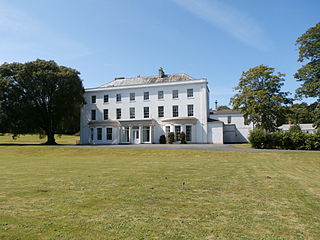
Moreton House is a grade II listed country house and former large estate near Bideford, North Devon, England. The house is about one mile west of the old centre of Bideford town, its entrance drive leading off the south side of the road between Bideford and the village of Abbotsham. It has in recent years become increasingly surrounded by the suburbs of Bideford, and in 2014 only 5 acres of the former parkland remain attached to the house. The estate is said anciently to have been the property of the famous Grenville family, lords of the Manor of Bideford, and of Stowe, Kilkhampton in Cornwall. It was later acquired by the Buck merchant family of Bideford, which rebuilt the house in 1760 and again in 1821.
Colonel Sir George Stucley Stucley, 1st Baronet DL, known as George Buck until 1858, was a British Conservative Member of Parliament.
William Rosewell was the Solicitor-General to Queen Elizabeth between 1559 and 1566.
Bottreaux Castle, colloquially known as The Courte during the time John Leyland visited, is a ruined motte and bailey castle in Boscastle, England. It was originally built in the 12th century and only earthworks remain today.

Knowstone is a village and civil parish situated in the North Devon district of Devon, England, halfway between the Mid Devon town of Tiverton, Devon and the North Devon town of South Molton. The hamlet of East Knowstone lies due east of the village. Knowstone was the birthplace of Admiral Sir John Berry (1635–1691), second son of Rev. Daniel Berry (1609–1654), vicar of Knowstone cum Molland. An elaborate mural monument erected by Sir John in 1684 to the memory of his parents survives in Molland Church.

Forrabury and Minster is a civil parish on the north coast of Cornwall, England, United Kingdom. The parish was originally divided between the coastal parish of Forrabury and inland parish of Minster until they were united on the 1st of April 1919.

Affeton Castle is a converted late-medieval gatehouse near East Worlington, Devon, England. It was formerly part of the fortified manor house of Affeton, built by the Stucley family in about 1434, and situated on the side of a valley of the Little Dart River. The manor house was destroyed in the English Civil War of the 1640s, and by the early 19th century the gatehouse was in ruins. It was restored between 1868-9 by Sir George Stucley, 1st Baronet for use as a shooting box or hunting lodge; in 1956, it was converted to form the private home of Sir Dennis Stucley, 5th Baronet. The castle, approximately 60 feet by 22 feet in size, is protected as a Grade II* listed building.

The Parish Church of the Annunciation to the Blessed Virgin Mary is the Church of England parish church of Souldern, a village in Oxfordshire about 7 miles (11 km) northwest of Bicester and a similar distance southeast of Banbury.
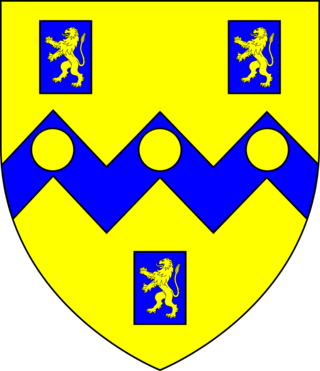
George Rolle of Stevenstone in the parish of St Giles in the Wood near Great Torrington in Devon, was the founder of the wealthy, influential and widespread Rolle family of Devon, which according to the Return of Owners of Land, 1873 in the person of Hon. Mark Rolle, the adoptive heir of John Rolle, 1st Baron Rolle, had become by that year the largest landowner in Devon with about 55,000 acres. He was a Dorset-born London lawyer who in 1507 became Keeper of the Records of the Court of Common Pleas and was elected as a Member of Parliament for Barnstaple in 1542 and 1545. He became the steward of Dunkeswell Abbey in Devon, and following the Dissolution of the Monasteries he purchased much ex-monastic land in Devon. Not only was he the founder of his own great Devonshire landowning dynasty but he was also an ancestor of others almost as great, including the Acland baronets of Killerton, the Wrey Baronets of Tawstock and the Trefusis family of Trefusis in Cornwall now of Heanton Satchville, Huish, later Baron Clinton, heirs both of Rolle of Heanton Satchville, Petrockstowe and of Rolle of Stevenstone.

Sir Thomas Denys of Holcombe Burnell, near Exeter, Devon, was a prominent lawyer who served as Sheriff of Devon nine times between 1507/8 to 1553/4 and as MP for Devon. He acquired large estates in Devon at the Dissolution of the Monasteries.

The landed gentry and nobility of Devonshire, like the rest of the English and European gentry, bore heraldic arms from the start of the age of heraldry circa 1200–1215. The fashion for the display of heraldry ceased about the end of the Victorian era (1901) by which time most of the ancient arms-bearing families of Devonshire had died out, moved away or parted with their landed estates.

The Manor of Molland was a medieval manor in North Devon, England. It was largely co-terminous with the existing parish of Molland, in which is situated the village of Molland. More accurately it consisted from the earliest times of two separate manors, held from separate overlords, later known as Molland-Bottreaux and Molland-Champson.
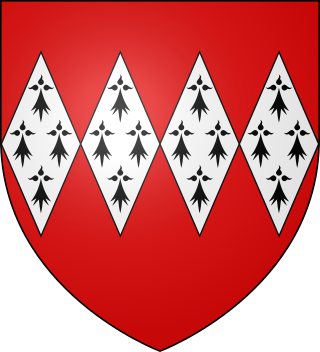
Sir John Dinham (1359–1428) was a knight from Devonshire, England. His principal seats were at Hartland in North Devon, Kingskerswell and Nutwell in South Devon, Buckland Dinham in Somerset and Cardinham in Cornwall. He killed one of the murderers of his father in Exeter Cathedral, for which he was pardoned by the king. He later broke into Hartland Abbey and assaulted the Abbot over a long-standing disagreement, and also performed other acts of violence. He married three times; his heir was John Dinham (1406–1458). His monument survives in Kingskerswell parish church.
Lewis William Buck (1784–1858) of Moreton House, Bideford, and Hartland Abbey, Devon, was Member of Parliament for Exeter 1826–32 and for North Devon 1839–57, and was Sheriff of Devon in 1825/6. A full-length portrait of Lewis William Buck by Francis Grant (1803–1878) was presented to him by the people of North Devon after he had served eighteen years as their MP, now displayed in the billiards room of Hartland Abbey, with his electioneering posters on each side.
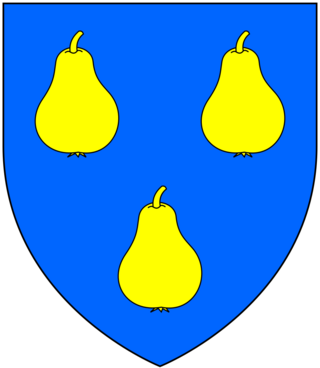
Sir Hugh Stucley (1496–1559) was the lord of Affeton in Devon, and Sheriff of Devon in 1545. His third son was Thomas Stukley, known as "The Lusty Stucley".
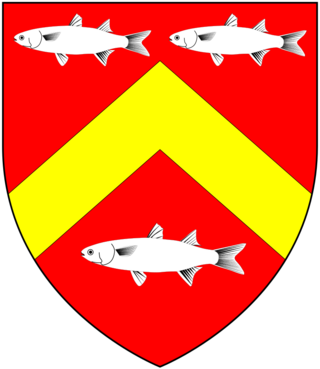
John Militon of Pengersick Castle in the parish of Breage in Cornwall, was Governor of Saint Michael's Mount, Cornwall, in 1547.
Geoffrey Chamber was a legal advocate, an associate and agent of Thomas Cromwell's, and was Surveyor and Receiver-General to the Court of Augmentations at the time of the Dissolution of the Monasteries. He was connected with the discovery of the mechanical contrivances in the Rood of Grace at Boxley Abbey.